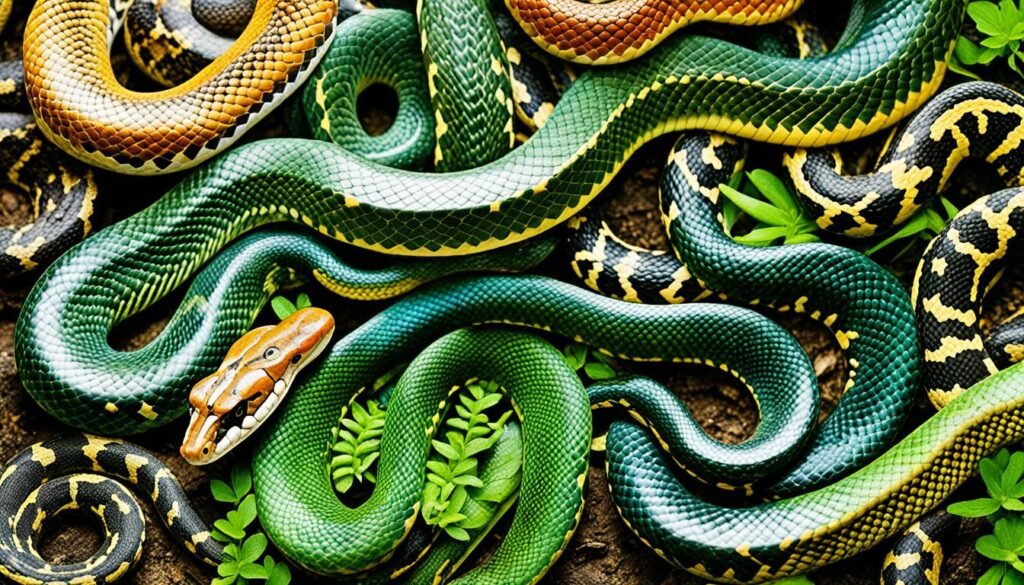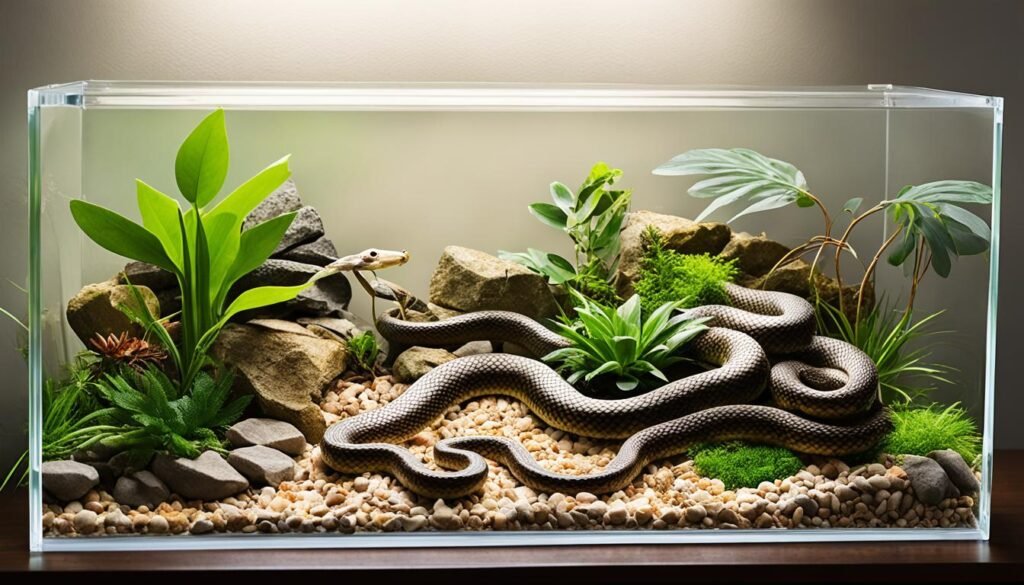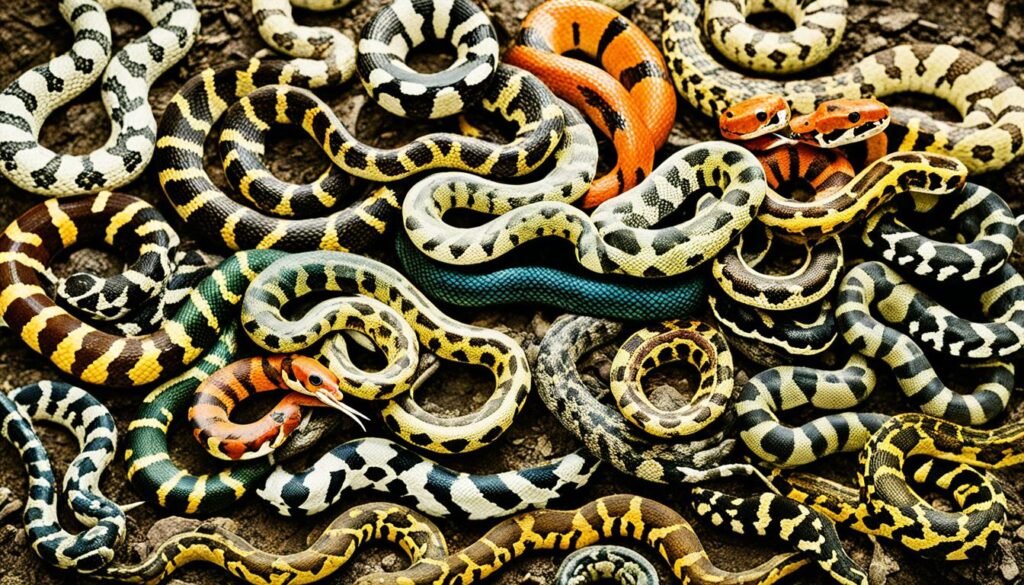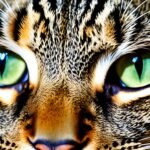Bringing a pet snake into your home is like opening a door to a mystical world. You’ll find the top 10 snake pets offer beauty, peace, and companionship. If you’re new to snake ownership, it might seem hard. But, learning about proper care is rewarding for you and your snake. Think of your snake’s terrarium as a window to nature. It recreates their natural homes. From the eye-catching Corn Snake to the gentle Ball Python, there’s a snake out there for everyone.
Snakes are great for those who like simple care and living. They need a warm spot in their tank, and food that mimics what they eat in the wild. In a cozy terrarium, they live happily away from their natural wild life. But, remember, choosing a snake is a big commitment. These pets can live up to 20 years. Bringing a snake home adds exotic flair but also brings long-lasting responsibility that makes life richer for both of you.
Why Snakes Make Remarkable Pets

For those looking for a unique pal, snakes are a great choice. They move gracefully and come in many kinds. They are not just for pros. Best snake pet options exist for beginners too. Learning snake basics for beginners is key for everyone’s safety.
Snakes are not only cool to watch but also easy to care for. They eat once a week, unlike other pets that need daily meals. Corn snakes are hardy pets. They’re strong and can live in different places, making them a top pick for newbies.
Snakes are in it for the long haul, living 15 years or more. Animals like corn snakes and ball pythons offer lasting friendship with proper care.
Snakes are the second largest group of reptiles, with 3,789 species worldwide, displaying an astonishing diversity in behaviors and habitats.
Their super smelling skills are amazing. Thanks to their tongues and Jacobson’s organ, they can ‘taste’ the air. They move in up to five forms of locomotion. Watching them eat, stretching their jaws to swallow big prey, is truly a sight.
Thinking about getting a snake pet? Most snakes aren’t dangerous. In the U.S., only four venomous kinds are common. Knowing which snakes are safe comes with learning and help from online communities and rescue organizations.
Having a snake is more than just fun. It’s about respect and knowledge. While many fear snakes, proper care reduces risks. This creates a safe space for both pet owners and their snakes.
Snakes charm their way into our lives with their silent slides. Caring for them offers a unique and rewarding adventure. Both new and seasoned pet owners can find joy in this journey.
Understanding the Basics of Snake Care
Starting your journey with a snake means fully committing to their care. It starts with choosing the right home for them. This choice depends on the type of snake you get and its needs. Whether it’s a gentle corn snake or a grand boa, their home is key to their health. It must be escape-proof to keep these crafty creatures safely inside.
For every snake, creating the right home environment is key. For beginner favorites like corn snakes, you need to keep the home humid but not wet—aim for 40-50% humidity. You also need to get the temperature just right, with a warm spot and a cooler area. Plus, they need a bit of UV light to stay healthy.
- New snake owners must know what to feed their pet. The food should be just the right size and properly prepared.
- When handling your snake, be gentle and don’t overdo it. Short sessions are best for both you and your snake.
To truly care for a snake, you need the right gear and knowledge. Also, remember they need space for their food storage. By setting up the perfect home, you create a safe place for your snake to live a long, happy life.
Getting the perfect home and learning about snake care are key. They help you build a strong bond with your new snake, ensuring you both get along well.
Popular Pet Snake Types to Consider for Beginners

Starting your snake-owning journey is exciting, especially when choosing the right type for beginners. There are many snake breeds. They differ in size, behavior, and needs. This makes some better for those new to snake care. Beginners often pick the rosy boa, corn snake, and ball python. They are known for being gentle and easy to look after.
Small snakes are good for new owners because they’re easier to handle. Take the corn snake—it grows only to 2-5 feet long. This makes it perfect for beginners, even those with young kids. Corn snakes are simple to care for. They usually don’t need live food, making them a preferred choice.
Children’s Python: An Aussie Favorite
The Children’s Python comes from Australia. It’s small and easy-going, perfect for those new to snake care. These pythons are peaceful and like to climb. They’re easy to take care of. This sets them apart from other snakes.
Carpet Python: The Tree Dweller
Carpet Pythons come from Australia. They can grow large and have beautiful colors. Juvenile Carpet Pythons can be quite active. But as they grow, they become calm. They like to climb, so their homes need to have things to climb on.
Gopher Snake: The Gentle Imitator
Gopher Snakes are from western North America. They can grow from three to six feet long. When scared, they shake their tails like rattlesnakes. But they are not venomous and very gentle. This makes them great for beginners looking for an easy-care snake.
Bigger snakes like Anacondas and Burmese Pythons might be too much for new owners. They need a lot of space and special care. When choosing a snake, think about its size, what it eats, and how much care it will need. This helps make sure you and your pet will be happy.
Buying from a trusted place is important. It means you’re more likely to get a healthy snake. It also helps the snake adjust better to living with you. With so many types of snakes, there’s a perfect one for every beginner. Ready to start the adventure of snake keeping.
Pet Snake Types That Thrive in Captivity

When looking for pet snakes that do well in captivity, certain species stand out. They are adaptable and easy to care for. This makes them great choices for both experts and beginners. These snakes are not only colorful but also safe house pets.
Milk Snake: The Misunderstood Beauty
Milk snakes are perfect examples of snakes that thrive in captivity. Even though they look like certain venomous snakes, milk snakes are harmless and friendly. They can live up to 20 years, displaying beautiful colors and patterns. It is key to house them separately to avoid fights.
Garter Snake: The Dayactive Slitherer
Garter snakes are ideal for those who like to watch their pets during the day. These snakes are active in daylight and have colorful markings. They eat a variety of foods including small fish. Garter snakes are small and lively, making them fun pets that are easy to care for. Just ensure their diet is varied for their health.
Rosy Boa: The Desert Gem
The rosy boa, from the deserts of the western U.S. and Mexico, also makes a great pet. They are calm and easy for beginners to handle. With the right care, including proper temperatures and a rodent-based diet, they can live a long life. No UV-B light is necessary for them.
Owning a snake is a big responsibility. You need to know their lifespan and how to care for them. Proper environment and diet are key to avoid health issues. Milk snakes, garter snakes, and rosy boas are all beautiful pets that can bring a lot of joy.
Top Considerations When Choosing Your First Pet Snake

Choosing your first pet snake requires careful thought about their needs. Many people give up pets because they don’t understand these needs. Snakes are very different from cats and dogs.
Size is very important when picking a snake. Corn snakes are good for beginners because they are small. They usually grow to 4 or 5 feet. Boas, however, are bigger and need more space and care.
Size Matters: From Corn Snakes to Boas
Corn snakes are great for starters. They are gentle and easy to handle. Boas are bigger and need a big living space. Learning about their growth helps you prepare for their care.
Temperament and Handling: What to Expect
Choose a snake that is easy to handle. Corn snakes are good because they are calm. They might bite if scared but are usually easy-going. Picking a snake that needs less care is also smart for beginners. Reptiles need vet visits but eat only once a week, which might be easier for busy people.
Snakes need the right environment to stay healthy. They can’t control their body temperature. So, you must keep their home at the right temperature. For corn snakes, this means 28 to 30 degrees Celsius.
Keeping things clean is also very important because of Salmonella. Always wash your hands after touching your snake.
Reptiles raised in captivity usually do better as pets than wild ones. Owning a pet snake means taking care of them for many years. Corn snakes live 10 to 15 years. This commitment brings a lot of joy in caring for your snake.
Essential Accessories for Your Pet Snake’s Enclosure
Each item in a pet snake’s terrarium helps mimic its natural home. The tank must be secure and the ground texture should match their natural environment. This setup is crucial, especially to prevent escape-prone snakes from getting out.
Make your snake’s life better with these essential items:
- Species-Appropriate Substrates: Choose the right ground for your snake to slither on. It helps them dig and keeps their tank warm, just like their wild habitat.
- Environmental Enrichment: Toys and dig boxes with different grounds are great. They keep your snake active and sharp.
- Hiding Spots: Snakes need places to hide to feel safe. Adding several hiding spots cuts down on their stress.
- Climbing Structures: Climbing branches or gyms are perfect for tree-loving snakes. They help keep your snake fit and entertained.
- Varied Scents: New scents are intriguing to snakes. But be careful, as some smells can make them lose their appetite.
- Water Bowl Maintenance: Clean water is a must. Change the water and clean the bowl often to keep your snake healthy.
Here are some useful facts to help you set up your snake’s home:
Take Ball Pythons, for example. They live for 30-40 years, growing from 10 inches to 5 feet. Young ones need a 10-gallon tank, but adults need 40-60 gallons.
Important environment tips:
- Maintain the air temp near 80°F and a warm spot at 90-92°F.
- Keep the humidity at 50-60% for healthy skin and breathing.
- Adjust feeding from every 5-7 days for babies to 7-10 for adults. Match prey size to the snake’s size.
- Give your snake 48-72 hours after eating before handling to avoid regurgitation and stress.
Understanding these snake care tips will help you create a home that keeps your snake healthy and happy.
The Lifespan of Popular Snake Breeds: Planning for the Long Term
Taking care of a snake is a big promise. It can last many years, even decades. Some snakes can live for more than 25 years in a good home. Knowing how long different snake breeds live is key for anyone thinking of getting one. Breeds like the Ball Python and the Children’s Python need a lot of care over many years. This means a big commitment for anyone bringing these beautiful animals into their home.
Caring for a Snake from Hatchling to Senior
Snakes need different things as they grow up. What they need changes from when they’re young to when they’re old. For example, young snakes need a small living space, but adult snakes need something much bigger. Their food, health care, and where they live need to change too.
Some snakes live up to 30 years. Their owners get to see them grow and change over time. One amazing thing is watching them shed their skin. It helps them grow and stay healthy by getting rid of parasites.
What Longevity Means for Pet Owners
Owning a snake for a long time is about more than just keeping them alive. It’s very rewarding but also means a lot of work and money. Choosing a snake breed means you’re ready for a long-lasting friendship. You need to create a good home for them for their whole life.
Planning ahead can make sure the snake and its owner are happy. It also helps endangered species. It reduces the problems caused by the pet trade and helps wild snakes too.
Common Myths About Snakes as Pets: Debunked
Thinking about getting a snake? You might hear a lot of myths. Some people think snakes are too dangerous for homes. They believe all snakes could hurt them with venom. But actually, many snakes at home aren’t poisonous at all. They’re safe when you take care of them right. Understanding snakes better can help us see they make great pets. They’re even kind by nature.
Myth vs. Reality: Understanding Non-Venomous Snakes
Most pet snakes are not venomous. They live well in tanks and are happy in our homes. Sometimes, myths make us scared of these pets. But knowing the truth matters. Non-venomous snakes, like corn snakes or ball pythons, are friendly. They’re perfect for beginners in snake care. These snakes need simple care and give back lots of joy.
The Truth About Snake Maintenance and Care
Some say snakes need too much work. That’s not true. Many snakes do well in cages and are easy to keep happy. You’ll need the right tank, regular feedings, and some time to hang out with them. With these simple steps, snakes can be great pets. Let’s forget the myth that all snakes are hard to take care of. They bring a lot of joy and are beautiful to have around.













